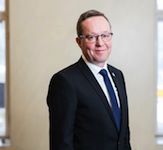
Transform sectors that use most resources into circular systems
What is circular economy? The goal of a circular economy is to replace our current linear system, in which finite natural resources are consumed and promptly wasted. This is in con-trast with a more sustainable circular system where resources are not discarded but recycled, reused, repaired, and shared.
The circularity of materials provides vast opportunities for businesses. A move towards a circular economy presents a system to build a more fair and inclusive society. It is an integral part of the toolkit for solving global challenges. For instance, the European Green Growth program is supporting and providing financial instruments to speed up the systemic trans-formation towards circular economy. When the combination of several crisis hit Europe, it provided an opening to continue and speed up the actions for sustainable recovery pro-grams.
A key player in the green transition is the industry itself. In Finland, they have developed their low-carbon roadmaps in close co-operation with the government. Our roadmaps, on the other hand, were published early in 2021. This helped us understand what the transition requires from different industries and from different sectors of society.
The roadmaps have shown tremendous potential for innovation, as the markets for new clean products and services keep growing.
Finland has taken actions on circular economy as part of the National Strategic Circular Economy Program and national Recovery and Resilience Plan. The transition into a circular economy is a step toward in achieving the Government’s carbon neutrality target by 2035. The national circular economy strategy set ambitious targets for consumption of non-renew-able natural resources, the productivity of resources and the circular material use rate. Fin-land’s strategy involves several policy instruments that provide funding for investments that nationally recycle key materials. Nevertheless, there is still work to be done.
In Finland, the focus of our roadmap work has widened from climate and carbon neutrality to resource related topics of circular economy. A large part of the resource-intensive industry has been utilizing circular economic solutions for years. The Finnish steel industry recycles a large part of European steel. The largest processes using virgin material are investigating the renewal possibilities offered by hydrogen economy and electrification. That said, virgin materials are still needed since green transition requires new materials and not everything is recyclable.
Bioeconomy has been based on the planned use of resources for decades, from forest management to the biodegradability and recyclability of products. There are several integrated recycling processes within these factories. The latest plants have energy-surplus processes providing both electricity and heat to their surroundings.
Mining, on the other hand, is still an industry that produces large amounts of waste. To tackle this, we must precisely seek for solutions within the framework of circular economy. The industry has already adopted responsibility as part of its operating principles, a principle that is still being developed. Additional waste streams and their potential as sources of both critical materials and bulk materials are currently being studied within the industry and by a national coordination group.
Green finance has continued growing year after year, and roadmaps are being established inside and outside the EU to encourage investors to finance the transition. Besides, higher climate ambition comes with more social ambition. Circular economy is one of the key sec-tors requiring a new approach for financing the transformation.
An open single market supports economic growth and the EU’s global competitiveness, and makes the EU an attractive destination for investments towards Circular and bio-based solutions. The European single market provides a good platform for safe, transparent and compatible circularity of goods and services. We have a long list of desires to boost circular economy including digitalization, innovation collaboration, industry policies and financing. They should all turn from a linear approach to circular value networks. The main message for all of us is that no one can undertake the process of circular economy and green transition alone. We need collaboration, new tools, new operating models and an innovative mindset.
Furthermore, a healthy business requires market demand. The circular economy is challenging the linear produce-use-discard-model by requesting longer use time, reparability and recycling of materials effectively. It also adds the value of moderation to markets and societies. Still the traditional products and services are often more cost effective in the short run. In Finland, we are experimenting innovative procurement models within a governmental program. This is already showing promising results.
A predictable operating environment for green transition is necessary for the future competitiveness of our businesses. The wider and innovative use of circular and bioeconomy solutions increase the EU’s resilience and open strategic autonomy by offering diversified sources of supplies.
The EU must realize the potential of bioeconomy for the existing resources in Europe, such as agriculture, wood and forest, sea and other bio-based materials. “Bioeconomy 2.0” will deliver bio-based, high value-added, renewable high-tech materials, components and end products from sustainable biomass sources to key European industrial value chains.
Bioeconomy is a sector where Europe can achieve a global technological leadership posi-tion. In addition to circular economy, bioeconomy should be an elementary part of the EU’s industrial policy and its existing instruments. There is a need for a swift transition from producing bio-based raw materials to producing high value-added bio-based products in Europe.




